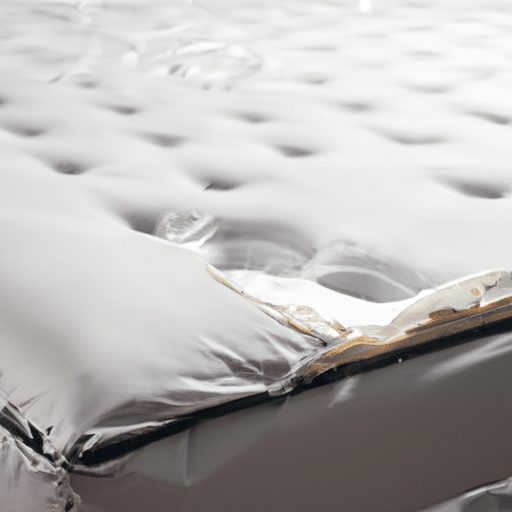Mattress off-gassing is a phenomenon that many of us may not be aware of, but it is something that could potentially impact our health and the quality of our sleep. When we purchase a new mattress, it often emits various chemical odors and Volatile Organic Compounds (VOCs) into the air, a process known as off-gassing. These odors and chemicals, which come from materials used in mattress production, can lead to respiratory issues, allergies, and even hormonal imbalances. In this article, we will explore the causes of mattress off-gassing, its potential health risks, and tips on how to minimize exposure to these harmful emissions. So, if you have ever wondered what that strange smell is when you bring home a new mattress, keep reading to find out more about mattress off-gassing and how to ensure a healthier sleep environment.
Review contents
What is mattress off-gassing?
Mattress off-gassing refers to the release of chemicals and volatile organic compounds (VOCs) from a new mattress. When a mattress is freshly manufactured, it often emits a distinct odor that is caused by these chemicals. This process is known as off-gassing and can potentially have health risks for individuals who are exposed to the chemicals released.
Definition of mattress off-gassing
Mattress off-gassing is the phenomenon where a new mattress releases chemicals and VOCs into the air. These substances are a byproduct of the materials used in the manufacturing process. Off-gassing typically occurs when a mattress is first unpacked and can persist for a varying amount of time, depending on factors such as chemical composition, age of the mattress, and environmental conditions.
Chemicals released during off-gassing
During off-gassing, various chemicals are released from the mattress. Some common chemicals include formaldehyde, benzene, toluene, and styrene. These chemicals are often used in the production of foam, adhesives, flame retardants, and other materials found in mattresses. While these chemicals may help improve certain properties of the mattress, their release into the air can pose potential health risks.
Common symptoms of mattress off-gassing
When exposed to mattress off-gassing, individuals may experience a range of symptoms. These can include headaches, dizziness, nausea, eye and throat irritation, respiratory issues, and allergic reactions. It is important to note that the severity of these symptoms can vary depending on the individual and the extent of their exposure to the off-gassing chemicals. If you notice any adverse reactions after purchasing a new mattress, it may be worth investigating the possibility of off-gassing.
Causes of mattress off-gassing
Chemicals used in mattress manufacturing
One of the primary causes of mattress off-gassing is the use of chemicals during the manufacturing process. These chemicals are often utilized to improve the performance, durability, and fire-retardant properties of the mattress. However, when the mattress is new, these chemicals can be released into the air as a result of the breakdown of the materials.
Volatile Organic Compounds (VOCs)
Volatile Organic Compounds, or VOCs, are another major contributor to mattress off-gassing. VOCs are carbon-based chemicals that have a high vapor pressure and easily evaporate at room temperature. Common VOCs found in mattresses include formaldehyde, toluene, and benzene. These VOCs can be released into the air and contribute to the distinct odor associated with off-gassing.
Flame retardants
Flame retardants are chemicals that are commonly used in mattress manufacturing to meet fire safety regulations. However, some flame retardants, such as polybrominated diphenyl ethers (PBDEs) and chlorinated tris, have been associated with negative health effects. When a mattress off-gasses, these flame retardants can be released into the air and potentially be inhaled by individuals.
Adhesives and glues
Adhesives and glues used in mattress construction can also contribute to off-gassing. These materials are often necessary for bonding different layers of the mattress together. However, some adhesives contain chemicals that can be released when the mattress is new. These chemicals can contribute to the overall off-gassing process and potentially pose health risks.
Health risks associated with mattress off-gassing
Respiratory issues
One of the primary health risks associated with mattress off-gassing is respiratory issues. The chemicals and VOCs released during off-gassing can irritate the respiratory system, leading to symptoms such as coughing, wheezing, and difficulty breathing. Individuals with pre-existing respiratory conditions such as asthma may be more susceptible to these effects.
Allergic reactions
Mattress off-gassing can also trigger allergic reactions in some individuals. The chemicals released during off-gassing have the potential to act as allergens, causing symptoms such as sneezing, itching, and skin rashes. Those with allergies or sensitivities to certain chemicals may be more prone to experiencing these allergic reactions.
Eye and throat irritation
The release of chemicals and VOCs during off-gassing can cause eye and throat irritation. Individuals may experience redness, itching, and a burning sensation in the eyes. Swelling, soreness, and a dry or scratchy throat may also occur. These symptoms are temporary and usually dissipate once the off-gassing process has completed.
Long-term exposure effects
While the short-term effects of mattress off-gassing are generally mild and temporary, the long-term effects of prolonged exposure to off-gassing chemicals are less understood. Some studies suggest that certain chemicals released during off-gassing may be associated with adverse health effects, such as respiratory problems, hormonal disruptions, and even cancer. However, more research is needed to fully understand the long-term implications.
Factors influencing the severity of off-gassing
Chemical composition of the mattress
The specific chemical composition of the mattress plays a significant role in the severity of off-gassing. Different types of mattresses, such as memory foam, latex, or hybrid, may contain varying levels of chemicals and VOCs. Additionally, the quality and manufacturing processes of the materials used can also influence the amount and duration of off-gassing.
Age of the mattress
The age of the mattress can affect the severity of off-gassing. Most of the initial off-gassing occurs shortly after the mattress is unpacked. As the mattress ages, the release of chemicals and VOCs decreases. Therefore, older mattresses may have a reduced off-gassing potential compared to brand new ones.
Room temperature and ventilation
Room temperature and ventilation are important factors that influence the off-gassing process. Higher temperatures can accelerate the release of chemicals and VOCs, making off-gassing more pronounced. Adequate ventilation, such as opening windows or using fans, helps to disperse the chemicals and reduce their concentration in the air.
Duration and intensity of use
The duration and intensity of mattress use can impact the off-gassing process. Typically, the majority of off-gassing occurs within the first few weeks of purchasing a new mattress. Regular use of the mattress, including sleeping on it, can help expedite the off-gassing process. However, intense or continuous use may prolong the off-gassing and expose individuals to a higher concentration of chemicals.
Reducing mattress off-gassing
Choose organic or natural mattresses
One way to minimize mattress off-gassing is to opt for mattresses made from organic or natural materials. These mattresses are manufactured without the use of harmful chemicals and are often free from synthetic materials, such as polyurethane foam. Organic and natural mattresses are generally less likely to off-gas and can be a healthier alternative for those concerned about exposure to off-gassing chemicals.
Opt for certifications and labels
When purchasing a new mattress, look for certifications and labels that indicate low VOC emissions or organic materials. Certifications such as CertiPUR-US, Global Organic Textile Standard (GOTS), and Global Organic Latex Standard (GOLS) ensure that the mattress meets specific standards for low emissions or organic materials. These certifications provide reassurance that the mattress has undergone testing and meets strict guidelines.
Allow proper ventilation
Properly ventilating the room where the new mattress is placed can help minimize off-gassing. Opening windows and doors, using fans, and utilizing air purifiers can help improve air circulation and reduce the concentration of chemicals. It is advisable to continue ventilating the room for several weeks after unpacking the mattress to facilitate the dissipation of any lingering off-gassing chemicals.
Use mattress protectors
Using a mattress protector can be beneficial in reducing off-gassing exposure. A mattress protector acts as a barrier between the mattress and the individual, minimizing direct contact and potential inhalation of off-gassing chemicals. Additionally, a mattress protector can help prevent spills, stains, and other damage, thus preserving the lifespan of the mattress.
How to minimize exposure to off-gassing chemicals
Air out the mattress
To minimize exposure to off-gassing chemicals, it is recommended to air out the mattress before use. Remove any plastic packaging, uncover the mattress, and allow it to breathe in a well-ventilated area for a few days. This helps in releasing any trapped chemicals and VOCs that may have accumulated during storage or transportation.
Use activated charcoal
Activated charcoal is an effective tool for absorbing and neutralizing odors, including those from off-gassing. Placing activated charcoal near the new mattress or using charcoal-infused products, such as mattress toppers or pillows, can help mitigate the odor and chemical emissions associated with off-gassing.
Keep the room well-ventilated
Continuing to keep the room well-ventilated beyond the initial airing out period can further minimize exposure to off-gassing chemicals. Open windows or use fans to promote air circulation, particularly in the early weeks after unpacking the mattress. This helps to disperse any residual chemicals and reduce their concentration in the air.
Avoid sleeping on a new mattress immediately
If possible, it is best to avoid sleeping on a new mattress immediately after unpacking. Allowing the mattress to off-gas and air out for a few days or weeks before using it regularly can help reduce exposure to off-gassing chemicals. This is especially important for individuals who are particularly sensitive to the odor or concerned about potential health risks.
Alternatives to traditional mattresses
Memory foam mattresses
Memory foam mattresses have gained popularity in recent years due to their ability to contour to the body and offer pressure relief. However, memory foam mattresses are known to off-gas more compared to other types of mattresses. Opting for memory foam mattresses that are CertiPUR-US certified or made with plant-based foams can help reduce the off-gassing potential.
Latex mattresses
Latex mattresses are known for their durability, comfort, and natural properties. Natural latex mattresses are made from sap derived from rubber trees and are considered to have low off-gassing potential. Look for latex mattresses that are certified organic or have undergone third-party testing to ensure they are free from harmful chemicals.
Innerspring mattresses
Innerspring mattresses are the traditional coil-based mattresses that have been around for decades. These mattresses typically have a lower off-gassing potential compared to foam-based mattresses. However, it is still important to research the specific materials used in an innerspring mattress to ensure they meet safety and emissions standards.
Hybrid mattresses
Hybrid mattresses combine different materials, such as foam and coils, to provide a balanced feel. The off-gassing potential of hybrid mattresses can vary depending on the materials used. When choosing a hybrid mattress, consider the individual components and their potential off-gassing properties. Opting for certified or low VOC hybrid mattresses can help mitigate off-gassing concerns.
Safety regulations and standards for mattresses
Global standards for mattress safety
Several global standards exist to ensure the safety and quality of mattresses. These standards set limits on the use of certain chemicals and emissions. Examples of such standards include the European Union’s REACH regulation, which restricts the use of harmful substances, and the Consumer Product Safety Improvement Act (CPSIA) in the United States, which sets guidelines for children’s mattresses.
Flame retardant regulations
Flame retardant regulations vary by country and region. These regulations are in place to reduce the risk of fire-related incidents. However, some flame retardants have been associated with health concerns. It is important to research the specific flame retardants used in a mattress and determine if they meet safety regulations and emissions standards.
Chemical emission certifications
Chemical emission certifications provide reassurance that a mattress meets certain standards for off-gassing. Certifications such as GREENGUARD Gold, OEKO-TEX Standard 100, and Greenguard Gold Indoor Air Quality ensure that a mattress has been tested for low emissions of VOCs and other harmful chemicals. These certifications can help consumers make informed purchasing decisions.
Signs of a low VOC or off-gassing mattress
Strong chemical odor
A strong, noticeable chemical odor is one of the most common signs of a mattress that is off-gassing. This odor is often described as a “new mattress smell” and can be present when the mattress is first unpacked. While some odor is normal, a strong and persistent smell may indicate a higher concentration of off-gassing chemicals.
Excessive outgassing duration
The duration of off-gassing varies depending on the mattress and environmental factors. However, if a mattress continues to emit a strong odor and chemicals for an extended period, it may indicate a higher level of off-gassing. Most mattresses will experience a reduction in off-gassing within the first few weeks of use.
Lack of certifications and labels
A mattress that does not have any certifications or labels indicating low VOC emissions or organic materials may be more prone to off-gassing. Certifications and labels provide assurance that a mattress meets certain safety and emissions standards. The absence of these certifications may indicate a higher likelihood of exposure to off-gassing chemicals.
Conclusion
Mattress off-gassing is a common phenomenon that occurs when a new mattress releases chemicals and VOCs into the air. While the short-term effects are generally mild and temporary, it is important to be aware of the potential health risks associated with prolonged exposure to off-gassing chemicals. By understanding the causes, health risks, and factors influencing off-gassing, individuals can make informed decisions when purchasing a new mattress and take steps to minimize exposure. Choosing organic or low VOC mattresses, proper ventilation, and allowing for adequate air out time can help reduce off-gassing and create a healthier sleep environment.































